🧬 Biocomputing with Living Cells: Programming Biology for Next-Gen Diagnostics and Therapies

Introduction: When Biology Becomes the New Computer
Biotechnology has entered a remarkable new phase — one where cells can be programmed to compute information, much like digital devices. Known as biocomputing with living cells, this field merges synthetic biology, systems biology, and computer science, enabling researchers to design biological "circuits" that can sense, process, and respond to environmental or disease signals.
This transformative concept is more than theoretical — it is already showing potential in smart diagnostics, programmable therapeutics, and real-time biosensing, making it one of the most exciting frontiers in biotechnology.
What Is Biocomputing in Living Cells?
At its core, biocomputing involves creating genetic circuits inside living organisms that function like the logic gates in a computer. These biological circuits allow cells to:
Detect inputs (such as toxins, disease markers, or stress signals).
Process information using engineered genetic logic.
Produce outputs (such as a measurable signal or therapeutic molecule).
Key Components:
DNA-based logic gates – control gene expression like digital switches.
RNA switches and ribocomputing – RNA molecules act as computational tools.
CRISPR-based circuits – programmable precision in genetic logic design.
Biological memory storage – cells engineered to "remember" past exposures.
Applications of Biocomputing in Biotechnology
The promise of biocomputing extends across medicine, environmental science, and beyond.
1. Smart Diagnostics
Cells can be programmed to detect disease biomarkers such as cancer-specific proteins, viral RNA, or metabolic changes.
Example: Engineered bacteria that glow when exposed to tumor markers.
2. Programmable Therapies
Biocomputing allows living cells to release drugs only when needed, reducing side effects and improving precision.
Example: Gut probiotics designed to sense inflammation and release anti-inflammatory compounds.
3. Environmental Biosensing
Engineered microbes can detect toxins, pollutants, or pathogens in water and soil.
Example: Biosensors that detect arsenic in drinking water.
4. Personalized Medicine
By programming cells from individual patients, therapies can be tailored for unique genetic and environmental profiles.
Recent Advances in Biocomputing
MIT’s Ribocomputing Devices: RNA-based tools that perform complex logical operations within cells.
Harvard’s Living Therapeutics: Engineered bacteria that function as "living drugs" for gastrointestinal disorders.
Synthetic Biosensors: Next-gen cell-based sensors capable of multi-input detection for more reliable diagnostics.
These breakthroughs highlight how biocomputing is bridging the gap between biology and computation in unprecedented ways.
Challenges and Future Directions
Despite remarkable progress, biocomputing with living cells faces key challenges:
Scalability: Ensuring reproducibility in large-scale applications.
Biosafety: Preventing unintended release or mutation of engineered cells.
Regulatory frameworks: Defining clear safety and ethical standards.
Complexity limits: Building more advanced logic systems in living cells without overwhelming their biology.
Looking ahead, the integration of AI-driven design tools, synthetic circuits, and bioinformatics could accelerate the design of even more complex biological computers. One day, programmable biology could enable cells that think, heal, and adapt in real time.
Conclusion: Reimagining Biology as Computation
Biocomputing with living cells represents a paradigm shift in biotechnology — one where biology itself becomes both the hardware and software of innovation. From smart diagnostics to programmable therapies, this field is poised to redefine medicine, environmental monitoring, and the very boundaries of human ingenuity.
🚀 Unlock the Future of Programmable Biology with BOLG
At BOLG, we believe in equipping the next generation of scientists and innovators with the tools to master breakthroughs like biocomputing, genetic circuits, and programmable biology. Through advanced courses, expert resources, and hands-on learning materials, you can transform your understanding of biotech into future-shaping expertise.
👉 Begin your journey today at www.bolg.co — where biology becomes the code of the future, and you are the programmer.